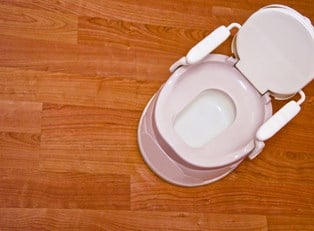Changing diapers can be the most intimidating part of being a new parent, particularly if you’ve never done it before. Not to worry -- there will be plenty of time for practice over the next two years. Diaper changing comes down to a few basic rules: figure out if it’s dirty, don’t get peed on, and make sure all the flaps or pins are firmly fastened. Here are a few tips for becoming a diaper changing expert.
What Are the Essentials for Diaper Changing?
First, diapers, of course. Disposable diapers are definitely the easier options, but many parents opt for cloth. Cloth diapers are not only gentler on your newborn’s bottom, but they also don’t wind up in landfills. Whichever you choose, make up your mind before Baby is born so you can stock up.
If you’re having trouble deciding what brand of diapers are best, start with the cheapest ones you can find. If your newborn is getting frequent diaper rash or the diaper is leaking all the time, try the next brand up, and go from there. If you choose cloth diapers, there are several different kinds, so grab a couple of each and see which works best.
Other vital essentials to have on hand include diaper rash cream, A&D ointment, and baby wipes. If you use powder, make sure to choose a cornstarch base NOT talcum powder, which has been associated with ovarian cancers. You’ll also need a safe space for changing all those hundreds of diapers.
How can I tell when it’s time to change a diaper?
Most disposable diaper brands have a small yellow stripe up the center of the diaper that turns blue when the diaper is wet. This is great for beginners, but you can also give the diaper a squeeze or a sniff. You can peek in the back of the diaper to see if it’s dirty or just wet. Disposable diapers are filled with a gel-like substance that expands and gets squishy when wet. Cloth diapers will feel heavier or warmer; they may seem to bunch up or change texture in other ways, depending on the diaper's material. As a general rule, however, most newborns shouldn’t stay in the same diaper for more than about two hours.
What should the contents look like?
For the first few days, stool will be black (meconium), but this will gradually fade. Baby poop looks different depending on formula or breastmilk and can vary slightly from baby to baby. Wet diapers may be very slightly yellow, but should be almost clear in a well-hydrated baby. If you’re still questioning, here’s everything you need to know about your baby’s poop.
Okay, but how do I actually change the diaper?
Grab your baby and everything you need so it's near at hand. Never leave your little one alone, even early on when she can’t move around much, on a high surface. Open the offending diaper (you can use the front flap to wipe some of the stool away if it’s a dirty diaper), and tuck it gently under Baby’s bottom to keep the wet part out of the way. For boy babies, it’s generally a good idea to lay your clean diaper open and over his bits, because boy babies can and will pee straight up in the air. Girl babies are not exactly exempt from that rule, so find a way that works for you to protect your face from fluids.
Wipe the entire area with a soft wet cloth or baby wipe. If the diaper is dirty, this can take several wipes. Make sure to get all the nooks and crannies to prevent infection. Tidy your wipes into the dirty diaper to be disposed of (if you opt for disposable diapers, a diaper genie is absolutely essential). Grasp Baby gently but firmly by the ankles or lower legs and lift her tushy up, then slide the clean diaper underneath. Applying A&D ointment can make poopy diapers easier to clean up (particularly on girl babies). If your little one is prone to diaper rash, use rash cream (zinc oxide) or powder every time to help protect sensitive skin. If diaper rash is present, apply rash cream liberally. If the rash is present for more than three days, give your pediatrician a call.
Fold the top up over her front (the top of the diaper should come to about the belly button). Depending on what kind of cloth diapers you choose, fastening may vary, so look for your specific cloth diaper. For disposable, make sure the elastic part that goes around the thighs is snug but not cutting off circulation, and on the outside of Baby’s bottom to prevent leakage. Pull the velcro straps from underneath and attach to the soft velcro on the front. If you aren’t sure which side is the front, look for brands with “front” and/or “back” printed into the design.



